Expand contents
Tropical tradescantias are generally treated as houseplants in temperate places like the Northern parts of Europe and the US. But it’s very hard to find conclusive information about what climates they actually can tolerate. Like many aspects of tradescantia growing, there’s been little or no formal research on the subject.
The RHS – the UK’s largest gardening resource – gives the common species seemingly arbitrary minimum temperatures. Closely-related cultivars of the same species are given minimums 10ºC apart with no apparent evidence or justification.
Over the last couple of winters, I’ve been experimenting with tropical tradescantias here in rainy Wales to find out what they can really take. This article documents my results so far.
Winter 2023-24: Full exposure
Over summer 2023 I had specimens of my whole collection in pots, on shelves in my sunny garden. When the weather started to cool down, I just left them as they were and watched what happened. I slowed and eventually stopped watering, but they stayed exposed to the elements and kept getting rained on all winter.
All the plants were completely unharmed as the weather started to cool into autumn. Even with lows dipping down to almost 0ºC, there was no damage whatsoever. Their growth slowed down but they were clearly healthy.
The first real cold snap was sudden, with several nights of lows down to -5ºC at the end of November. I went to assess the damage straight away.

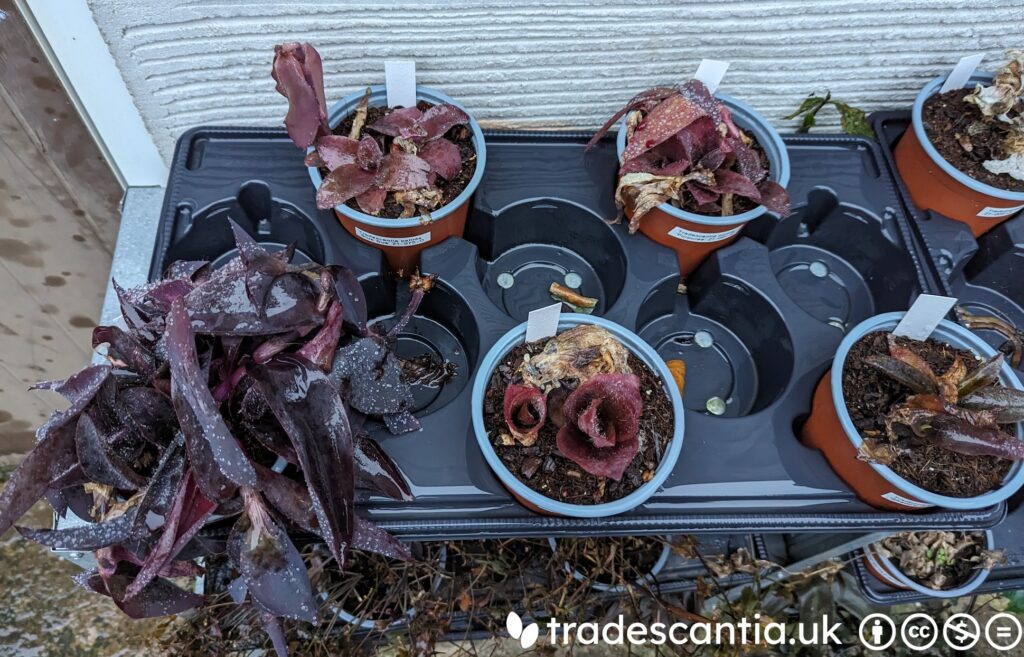
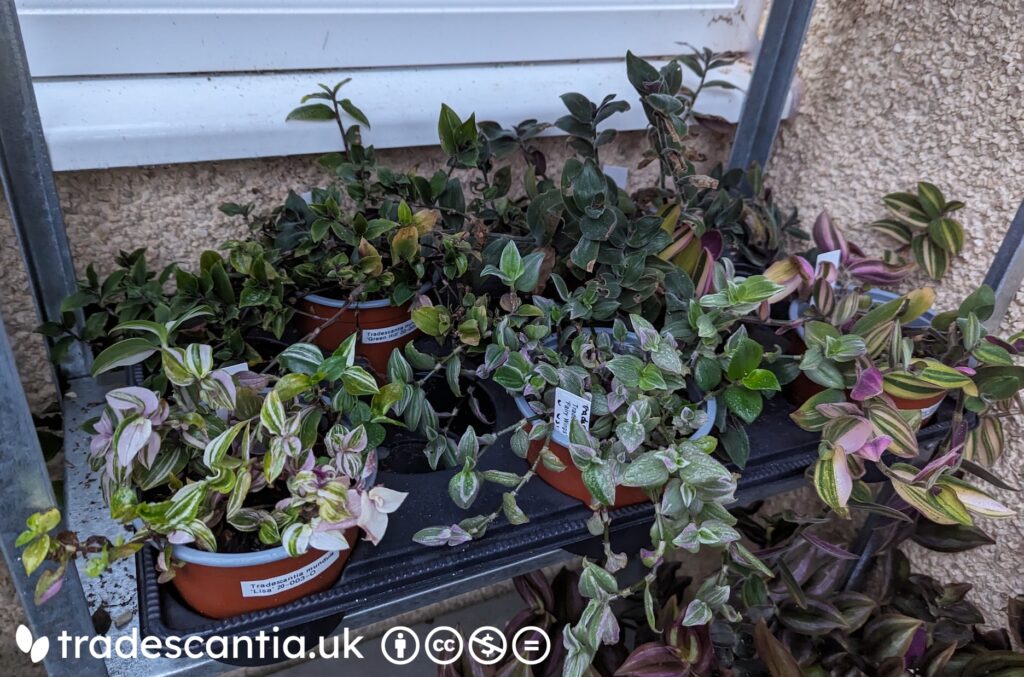
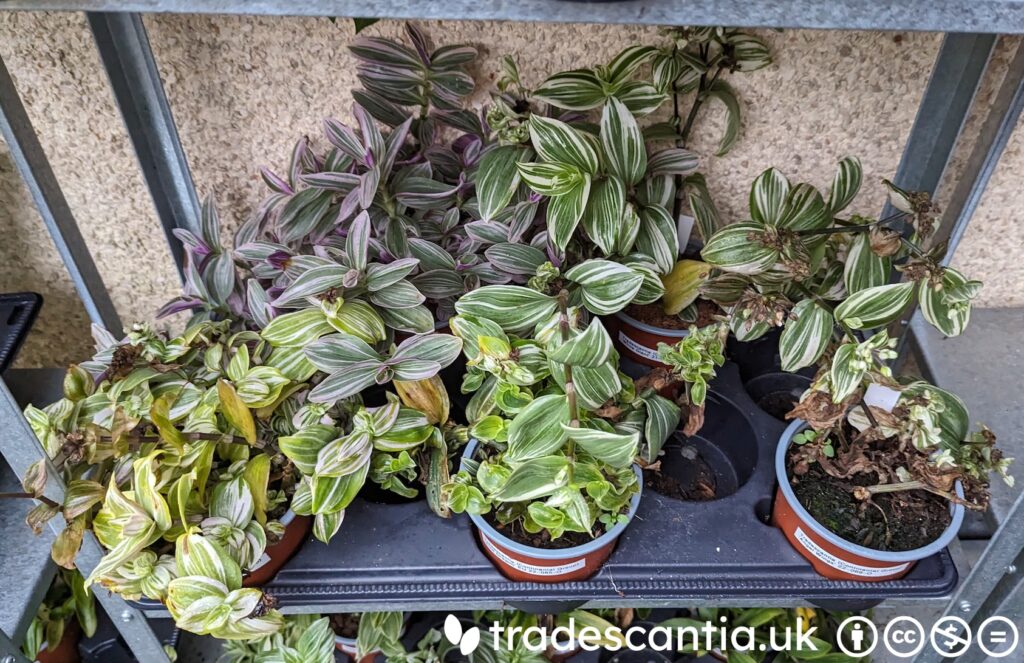
All the Tradescantia zebrina had melted dramatically as soon as the temperature went below freezing. The T. pallida seemed to have taken heavy damage too. I was surprised to see that most of the T. fluminensis and Continental Group cultivars seemed completely unharmed.
Over the next few months, most of the survivors gradually declined. I took another inventory after the last cold period at the end of January, which went down to almost -8ºC – very unusual for this area.

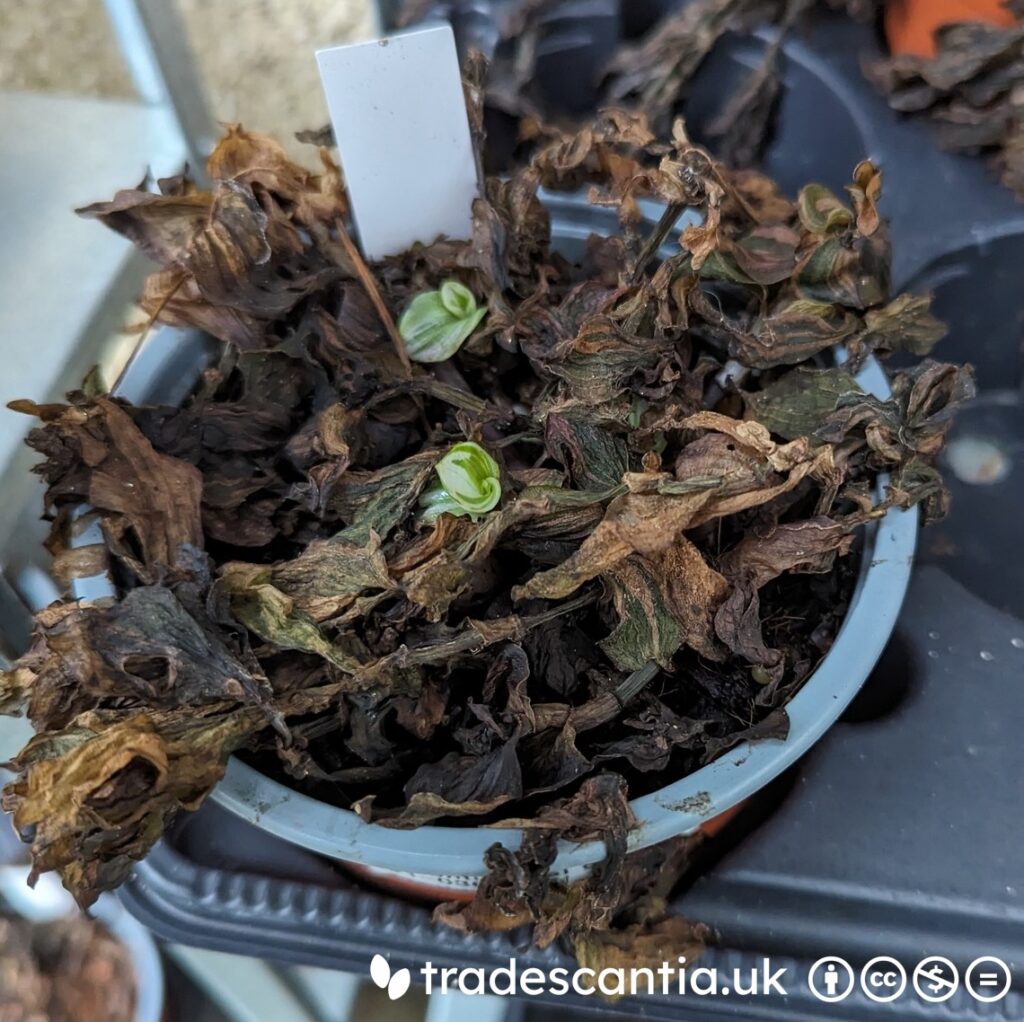

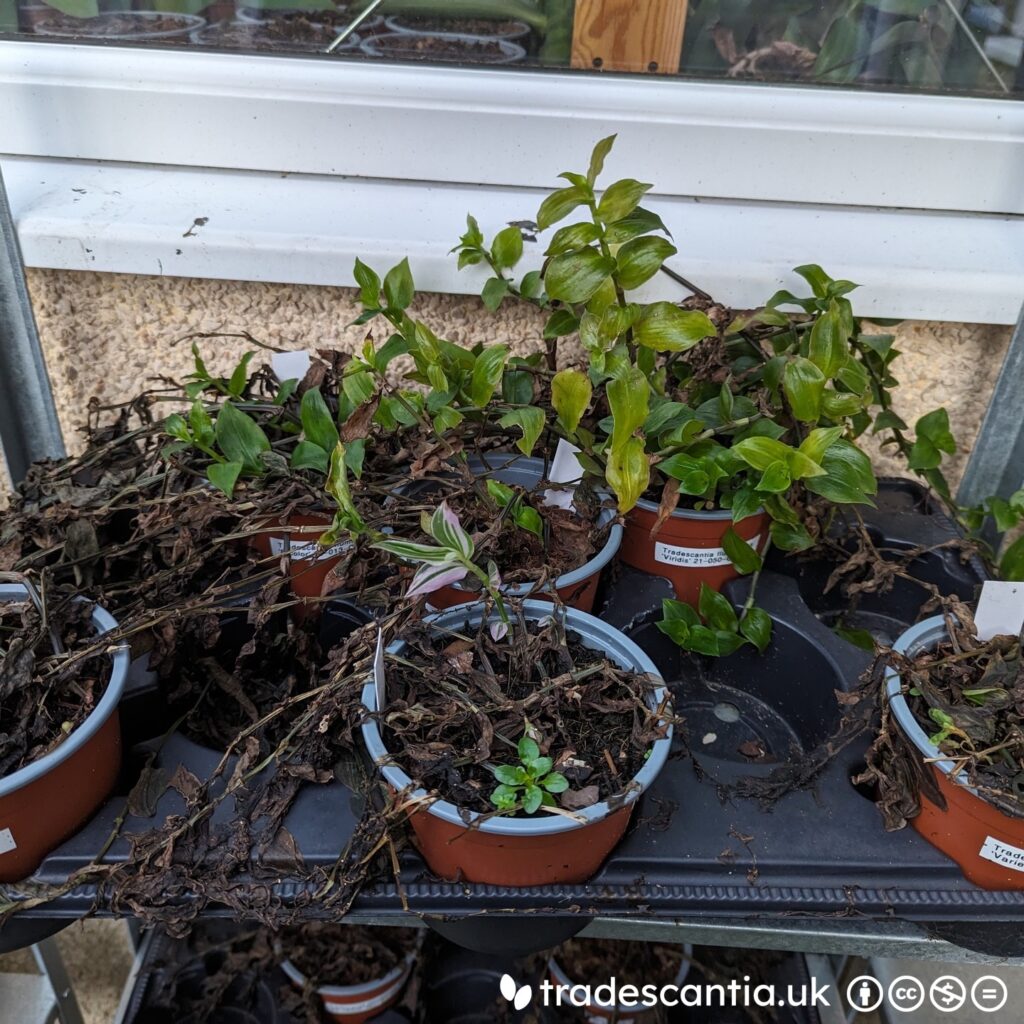
By then, almost all of the Continental cultivars were destroyed – with one lone survivor. And most of the other species had also rotted and melted away. But T. fluminensis and related species still appeared alive and well, with only minor damage.
By the time spring fully arrived, the situation hadn’t changed any more. When I repotted and restarted everything, I found a single buried stem in one of the T. pallida pots that was starting to make new growth. Other than that, all the plants that looked dead on the surface were dead right through.
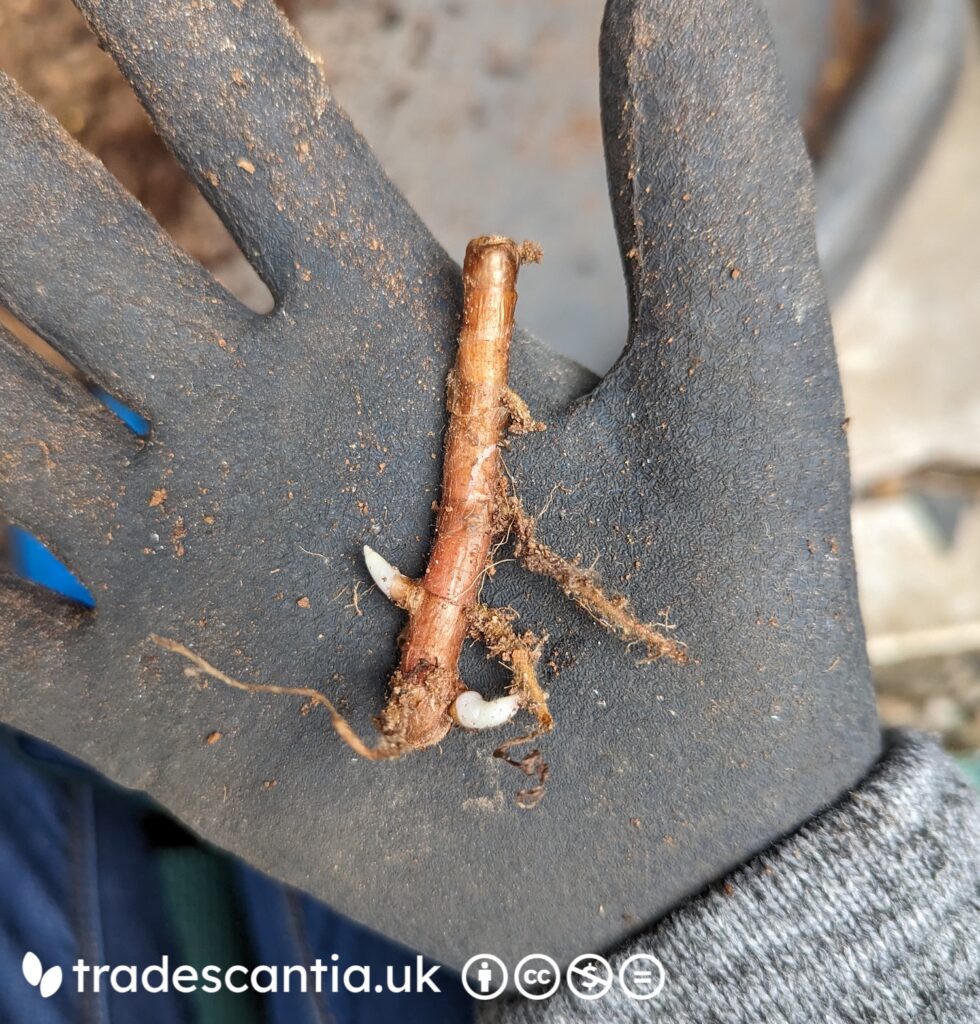
It seemed like I’d proved that tradescantias just can’t survive winter here. But several things were niggling at me.
- Lots of other growers report that T. pallida acts as a perennial and can grow back after a cold winter. Why did only one of mine do that?
- Many of the plants that eventually died appeared unharmed after the first cold snap. If they could cope with -5ºC for one night, why did they gradually die over the months when it was less cold than that?
- After the first frost, there were random scattered zebrina stems that seemed to have survived. Why?
The cactus hypothesis
I started to form a hypothesis that the cold-hardiness of tradescantias functions in the same was as the hardiness of cacti and other succulents.
Many people are surprised to learn that a lot of cacti and succulents can tolerate freezing temperatures. But it’s a vital adaptation for desert plants. Although we stereotypically associate deserts with heat, they often have extremely cold winter nights. And in fact, it’s the same adaptations that allow succulents to survive drought, which also help them survive cold.
Most plants need to stay well-hydrated at all times, and will quickly wilt and die if they’re deprived of water. But succulents have the ability to drastically reduce the amount of water held in their tissues, and still survive in a dormant state. When they become dehydrated, the sugars and minerals in their internal fluids become extremely concentrated. That in turn reduces the freezing point, and means that the water inside their cells can stay liquid at much lower temperatures than it otherwise would, which prevents ice damage. [1] [2] [3]
I noticed that the random zebrina stems that survived the first frost were all stems which had broken and were detached from the roots before it got cold. That meant they were dehydrated compared to the rest of the plants. And it seemed like that dehydration had helped them survive the cold in the same way as for other succulents.
Conversely, some of the plants that were able to survive a sudden but dry frost ended up rotting slowly over the milder and wetter months. That equally suggested that moisture levels were a major factor determining their winter tolerance. That one plucky T. pallida that grew back may have just happened to be in a sheltered enough spot that the soil didn’t get rained on directly, and so it was able to dry out and go dormant.
Winter 2024-25: Dry cold
As I came towards autumn 2024, I had a new plan for what to try next based on my cactus hypothesis. I’d shelter the outdoor plants from rain just to keep them dry, and see whether they coped better with the same low temperatures. I added clear plastic covers to the outdoor shelves as things started to cool down in autumn, and stopped watering completely in October.
In November, temperatures dipped to -2ºC for the first time, so I went to check the damage.
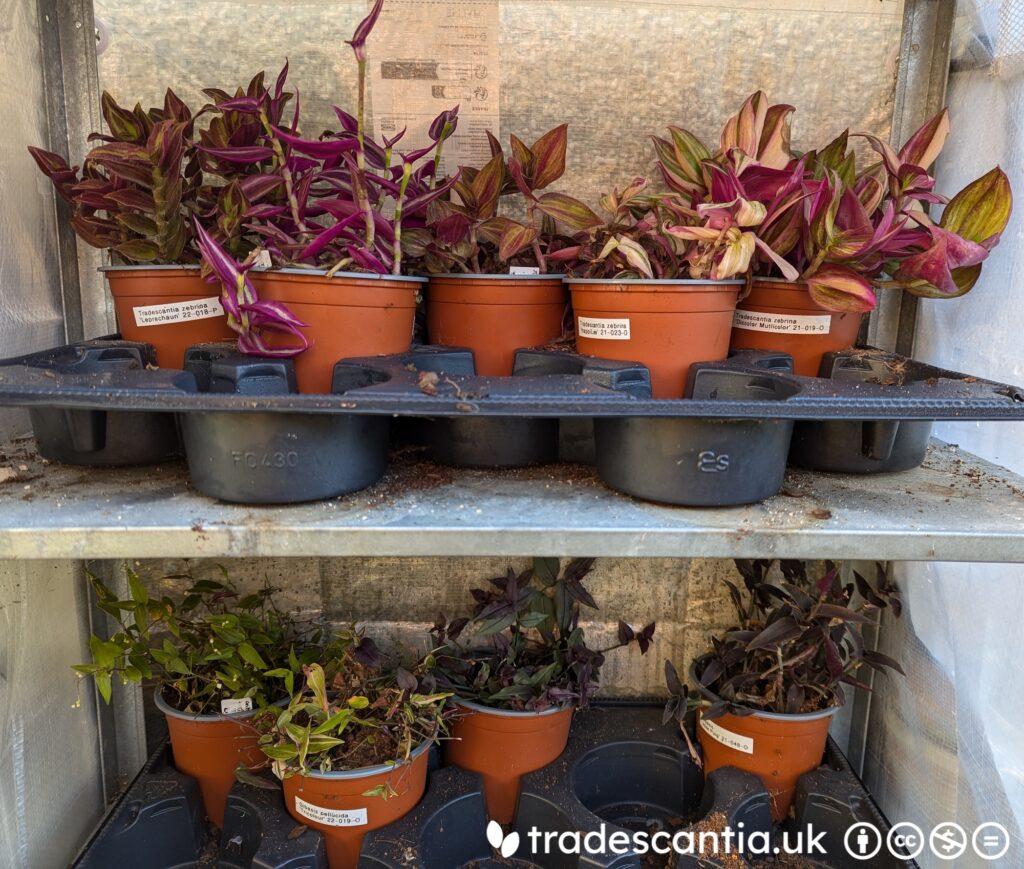


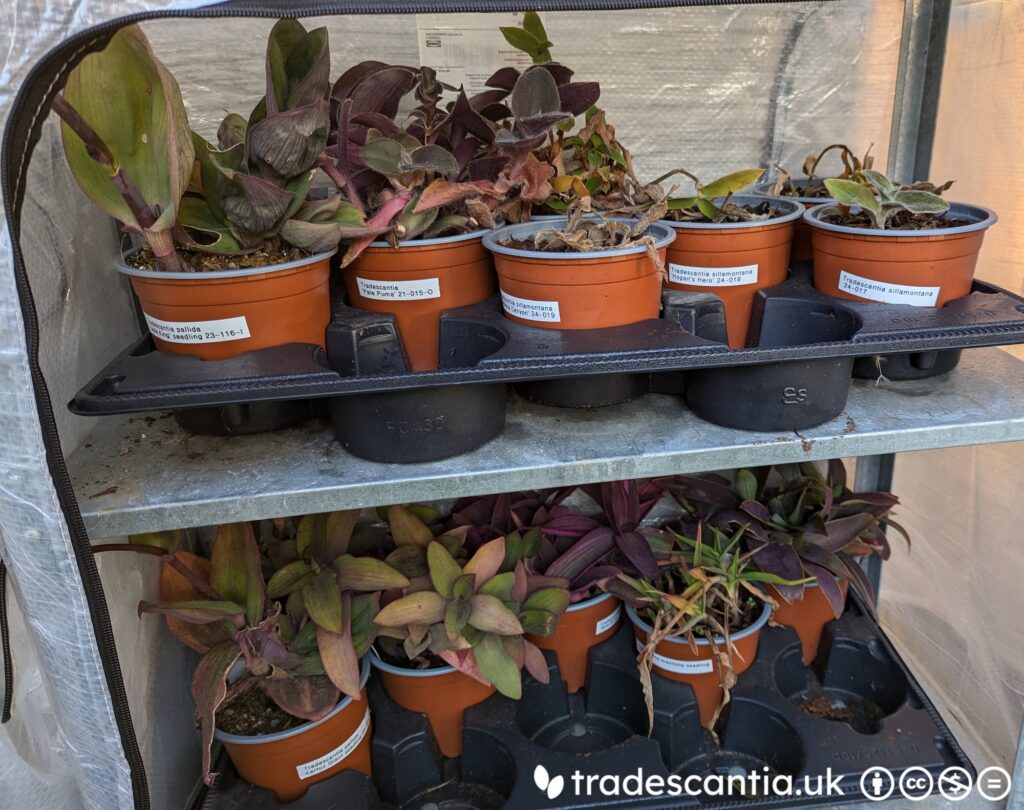
I was very pleased to find that all the plants were completely undamaged. Even the delicate T. zebrina were perfectly unharmed by the frost, thanks to being dry.
Over the rest of winter, lows went down to -5ºC. When spring came around, all of the plants were suffering – but not from rot. This time, they were wilting and crisping from dehydration.
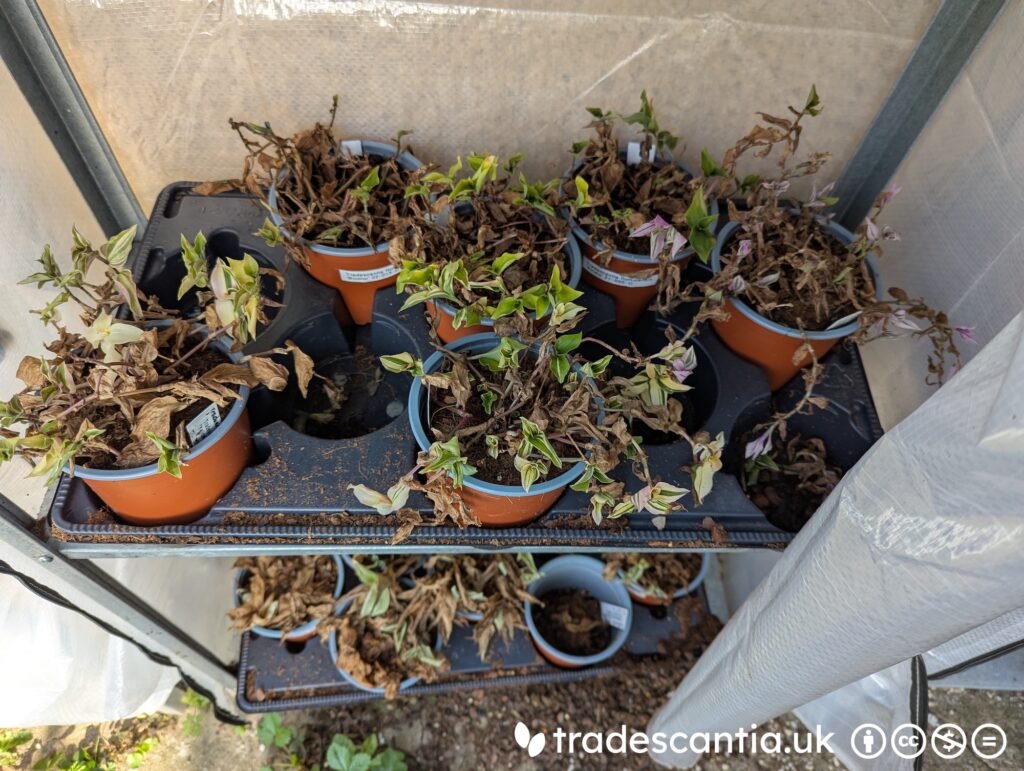
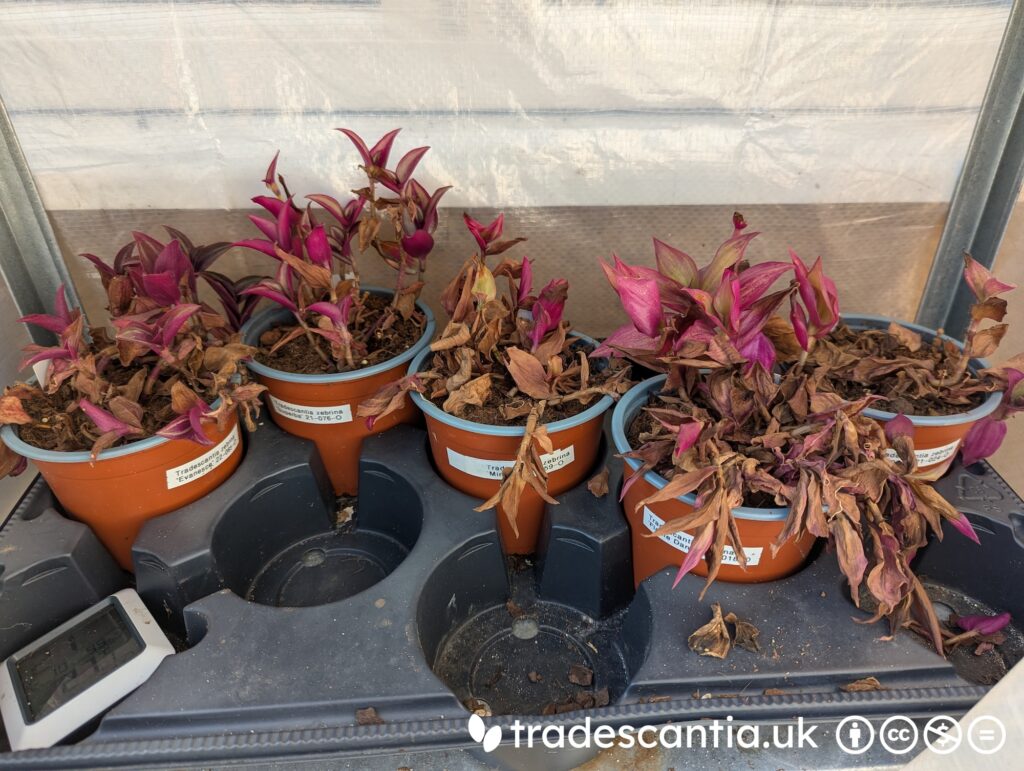

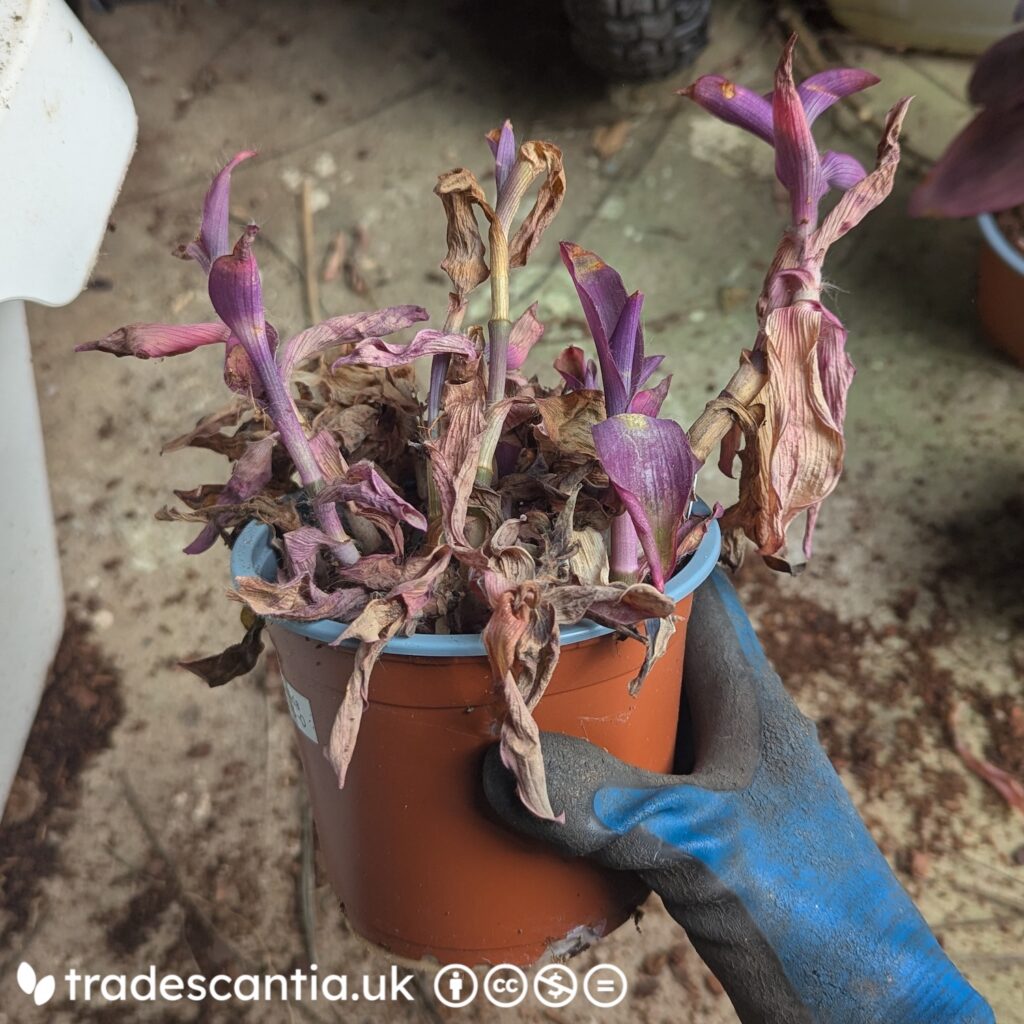
They all had lots of brown and crispy leaves. Some entire stems had shriveled away. And the surviving leaves were very flimsy and thin from lack of water. But almost all of them had some stems that were clearly still alive.
When I repotted and restarted all the plants, I found that even the ones which appeared completely dead on the surface usually had healthy roots and new growth beginning below the soil.
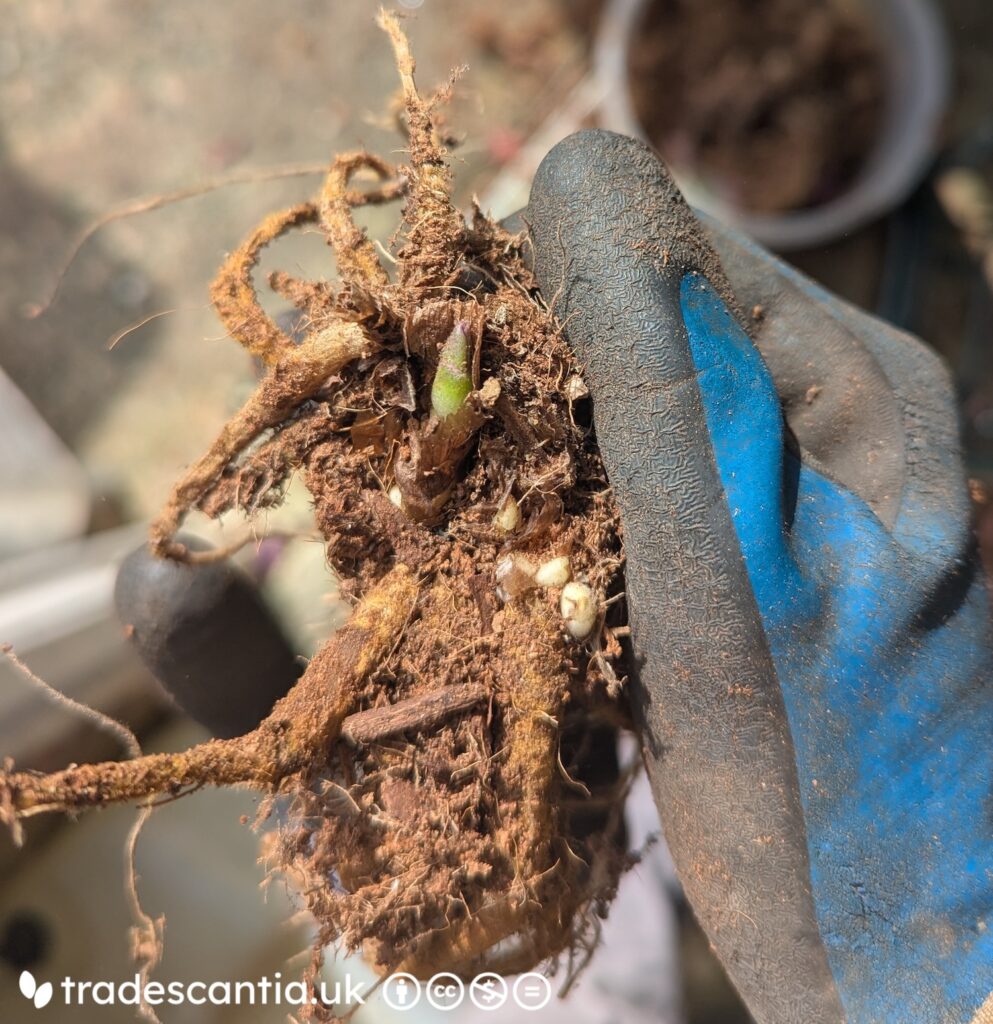

Next time?
I’m now thinking about what to try next. I managed to get most of the plants to pull through the winter by keeping them extremely dry. But they’ve all struggled, because dehydration is its own source of stress. Ideally I want to find a way to let them stay dry and dormant, but without getting progressively more dehydrated as the winter goes on.
My idea for now is to cover them and let them dry in the same way as before at the start of autumn. But once they’re dry and the weather has cooled enough to completely slow their growth, I’ll do a drastic cut back of their existing stems. Reducing the amount of leaves on the plants will reduce how much water they lose over time, and hopefully allow them to stay dormant while keeping a reasonable store of moisture in their roots and lower stems so they can recover easily in spring.
Conclusions and recommendations
I’m still in the process of experimenting to find the best way to keep tropical tradescantias alive through winter. So I don’t have totally definitive answers yet.
But I can certainly conclude that these plants are able to tolerate much colder temperatures than many people think. Even without any special treatment, all species were able to handle getting down to 0ºC with no damage whatsoever.
And I can also conclude that tradescantias – like many other succulents – cope with cold much better if they’re kept dry. If your winters are cold and wet, you can probably help your tradescantias survive better by simply sheltering them from rain without any other changes.
Found this article useful?
If you want more great resources like this, you can help me keep making them with a regular payment on Patreon.
References
- Ishikawa, M. & Gusta L. V. (1996). Freezing and heat tolerance of Opuntia cacti native to the Canadian prairie provinces. Canadian Journal of Botany, 74, 1890-1895. https://doi.org/10.1139/b96-226[↩]
- Goldstein, G. & Nobel, P. S. (1994). Water Relations and Low-Temperature Acclimation for Cactus Species Varying in Freezing Tolerance. Plant Physiology, 104, 675-681. https://doi.org/10.1104/pp.104.2.675[↩]
- Nobel, P. S. (1984). Extreme temperatures and thermal tolerances for seedlings of desert succulents. Oecologia, 62, 310-317. https://doi.org/10.1007/BF00384262[↩]

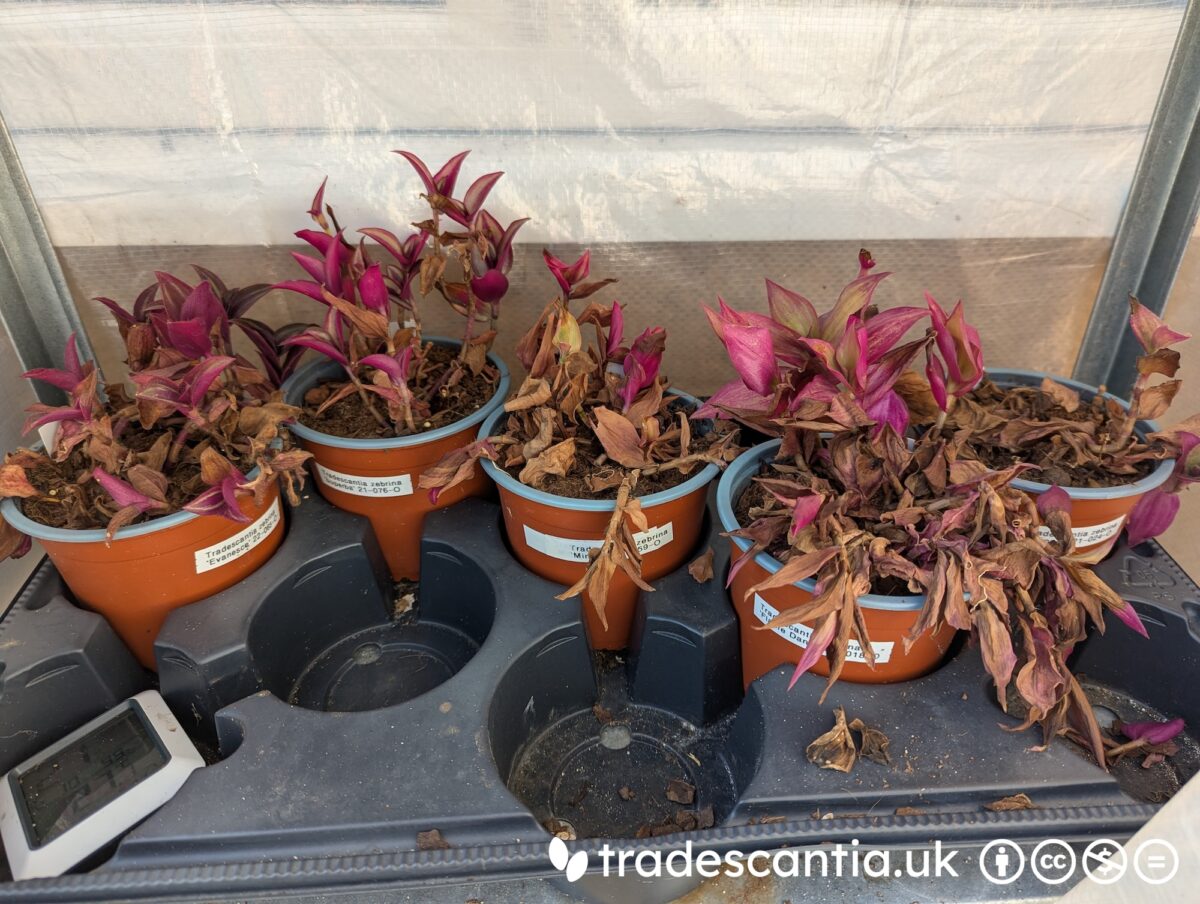
4 replies on “Tradescantias are more cold-hardy than they seem”
Very interesting! I’m looking forward to your next article and conclusions after the winter of 25/26.
Hi, thank your for sharing.
I grow Tradescantia (Zebrina, cerinthoides, fluminensis, Pallida, continental group) and some Callisia outdoors in the south of France. In winter, I move them into an unheated greenhouse and cover them with P30 frost fleece. They handled 0°C without any damage, with watering reduced to once a month.
One night, temperatures dropped to -3°C or maybe even lower. Some leaves got burned, but the outer cuttings protected the center, and the stems stayed alive. After that, I added a second layer of fleece — something I’ll definitely do again next winter.
I didn’t lose any Tradescantia varieties, even though I only had one pot of each. Sadly, Callisia ‘Dragon Tail’ and its variegated form didn’t survive. These plants are tough — and now I love them even more for it!
Thank you for the experiment.
I’ve kept some Tradescantia outdoors in The Netherlands for the past two winters.
One pot sits directly in the elements and gets direct and full rain and snow.
The other planter sits a bit further back and gets some rain and snow, but doesn’t get drenched.
Zebrina melted away both times and never came back up. This goes for the pot in full rain/snow and the pot that gets partially rained/snowed on.
For both pots: some of the pallida did die back, but came back up in the spring.
For both pots: sillamontana died back and came back in the spring.
For both pots: fluminensis and continental group got a little crispy, but survived above ground.
There were also some cerinthoides (nanouk and limelight) in the pot that got partially rained/snowed on and they survived with a little bit of crispy leaves.
I also had one pot with limelight that was kept completely dry and that got very crispy. Some parts died back, but it was in worse shape that the one in the partially rained on pot.
Maybe you can make two pots of each cultivar and keep one dry throughout the winter and sparingly water one for your 2025 winter experiment?
Interesting! I planted a Tradescantia pallida in a large pot in a somewhat sheltered position (beneath a tree) in western Germany (hardiness zone ~8a) last summer and didn’t protect it over winter. Temperatures reached -10°C on several occasions and there was also snow on several days. The visible parts of the plant died off but i was really surprised to find a newly emerged set of leaves in the early summer of the following year which looked very healthy. Interestingly, this applies to a Chlorophytum comosum (spider plant) next to it as well!